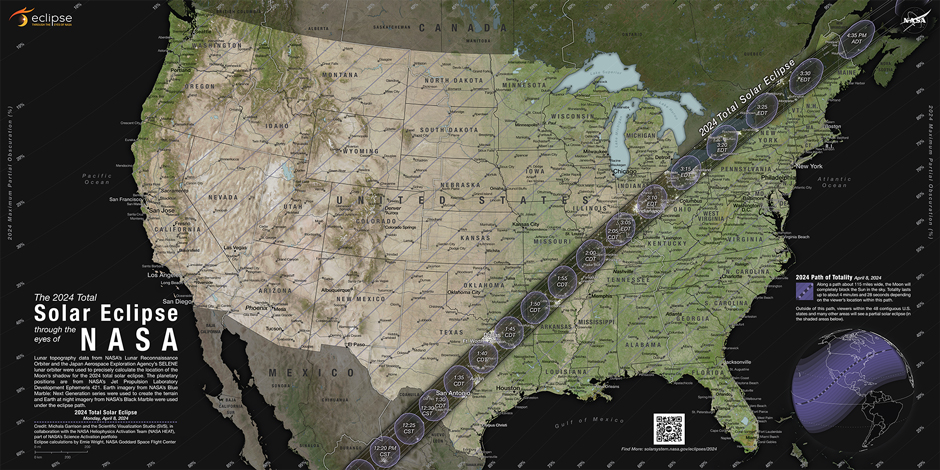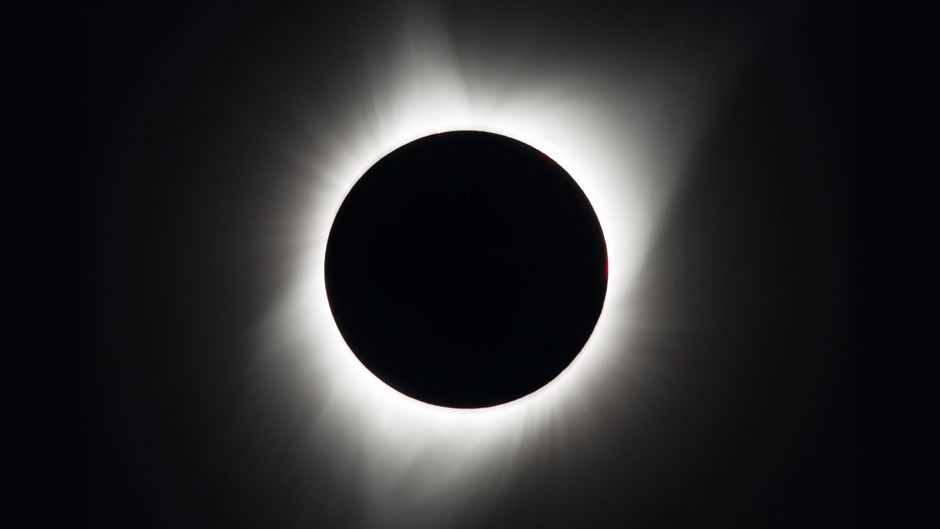Alessandro Peca’s curiosity for the cosmos began when he watched a partial solar eclipse from his hometown of Bertinoro, Italy. He was only 9, too young to fully comprehend the vast expanse of the universe but mature enough to know that he wanted to learn more about it.
“There was this eerie feeling as everything went cold and dark in the middle of the day. Even my dog knew something was up—he kept barking, sensing the odd vibe in the air,” recalled Peca, now a Ph.D. student studying astrophysics at the University of Miami College of Arts and Sciences. “That experience sparked my fascination with these celestial events, and I’ve been looking forward to witnessing a total solar eclipse ever since.”
On Monday, April 8, Peca will get his chance.
Along with a contingent of other astrophysicists as well as other scientists with a passion for the planets and its stars, he will witness what is being called the Great North American Eclipse of 2024 when the moon will blot out the sun along a roughly 4,200-mile-long, 100-mile-wide path across parts of Mexico, the United States, and Canada.

Peca will be attending an astrophysics symposium in Horseshoe Bay, Texas, one of the few locations in the country along the narrow path of totality, where the moon’s shadow will completely cover the sun. Most of the rest of the country will see a partial solar eclipse, with the moon obscuring only a part of the sun.
Wearing specialized eye protection, millions of people will watch the celestial show, marveling at the sight of Earth’s only natural satellite passing in front of the sun and turning day into night.
But solar eclipses are much more than spectacular shows in the sky, Peca said. “They’re also rich with learning opportunities for both professional astronomers and curious minds alike,” he explained. “For starters, they allow scientists to study the sun’s outer atmosphere, or corona, which is usually obscured by the bright light of the sun itself. This can help us understand solar winds and how they influence space weather, which impacts satellite communications and power grids on Earth.”
They have also helped validate important scientific theories. “The total solar eclipse of 1919 provided crucial evidence for Einstein’s theory of general relativity by showing how gravity can bend light,” Peca said.
That solar eclipses occur at all is what astronomers call a “cosmic coincidence.” Even though the sun is about 400 times larger than the moon, it is also roughly 400 times farther away from Earth, making the two appear almost the same size in our sky. And that is why the moon can completely block the sun’s light during a total solar eclipse. The stars, so to speak, have to align.
Whatever the case, scientists take advantage of the phenomenon when it occurs, training their telescopes skyward to investigate the sun’s corona and, in some instances, launching rockets during an eclipse to study how Earth’s upper atmosphere is affected when sunlight momentarily dims over a portion of the planet.
That is what NASA will do on April 8 as part of its Atmospheric Perturbations around Eclipse Path (APEP) project when the space agency will launch three instrument-laden sounding rockets from its Wallops Flight Facility in Virginia.
“The rockets will be able to do in-situ measurements of the ionosphere (the region of Earth’s atmosphere that is between 55 miles to 310 miles above the ground), and they will complement measurements from the ground to study how the ionosphere responds to the sudden lack of radiation and charged particles from the sun,” said Massimiliano Galeazzi, professor and chair of the College of Arts and Sciences Department of Physics.
“In addition to affecting fundamental science questions regarding the interaction of the Earth with the interplanetary environment and with solar winds, the ionosphere also plays a critical role in communications, as satellite signals, including the GPS used on our cellphones, is affected by it,” Galeazzi explained.
He recently visited the Wallops facility as part of his own research investigating the interaction of solar winds with the Earth’s magnetic field and the ionosphere, and while there, he and his team had the opportunity to see and inspect the sounding rockets that will launch during the April 8 solar eclipse.
Solar eclipses also occur elsewhere, in solar systems beyond our own. “Scientists study eclipses from exoplanets—planets around stars other than the sun—so we can learn more about other solar systems,” said Nico Cappelluti, an assistant professor of physics, who studies supermassive black holes and dark matter. “Other than participating in seminars about the topic, I’ve never had the chance to work directly with this kind of data. However, we do see eclipses around supermassive black holes as well, not by planets though, but from giant clouds of dust in the center of galaxies.”
When the eclipse begins, the sky, especially in locations that will experience totality, will darken as if it were dawn or dusk. But can such conditions have any temporary impacts on weather?
“There are actually some short-term effects, and it definitely depends on the location,” said Brian McNoldy, a senior research associate in the Department of Atmospheric Sciences at the Rosenstiel School of Marine, Atmospheric, and Earth Science. “Your typical puffy cumulus cloud is extremely sensitive to the amount of surface heating, so when you turn off the sun, even for a few minutes, they quickly dissipate. Once the eclipse is over, they reform and go about their cloud business.
“The effect,” McNoldy continued, “is most pronounced in the swath of totality and gradually diminishes the further away you go. And although it depends on several factors, the air temperature can also drop by about 10 degrees Fahrenheit during totality and gradually less as you move away from totality.”
During the 2017 eclipse, the temperature on Virginia Key, where the Rosenstiel School is located, fell by 4 degrees Fahrenheit, according to McNoldy. “We had 80 percent blockage,” he said.
McNoldy will have a real-time long satellite animation to capture the April 8 eclipse.
As for Peca, the Ph.D. astrophysics student, he has his special solar eclipse glasses ready and plans to watch the big event on Monday.
“While eclipses are a marvel to behold,” he said, “they’re also a window into the workings of our solar system and beyond, highlighting the ongoing dance between light, gravity, and time.”

